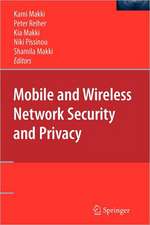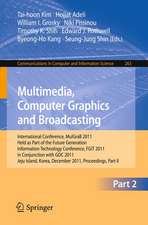Mobile and Wireless Internet: Protocols, Algorithms and Systems
Editat de Kia Makki, Niki Pissinou, S. Kami Makki, E.K. Parken Limba Engleză Paperback – 9 noi 2012
| Toate formatele și edițiile | Preț | Express |
|---|---|---|
| Paperback (1) | 651.42 lei 6-8 săpt. | |
| Springer Us – 9 noi 2012 | 651.42 lei 6-8 săpt. | |
| Hardback (1) | 660.99 lei 6-8 săpt. | |
| Springer Us – 31 iul 2003 | 660.99 lei 6-8 săpt. |
Preț: 651.42 lei
Preț vechi: 814.28 lei
-20% Nou
Puncte Express: 977
Preț estimativ în valută:
124.66€ • 129.36$ • 104.20£
124.66€ • 129.36$ • 104.20£
Carte tipărită la comandă
Livrare economică 15-29 martie
Preluare comenzi: 021 569.72.76
Specificații
ISBN-13: 9781461349747
ISBN-10: 1461349745
Pagini: 416
Ilustrații: XXI, 391 p.
Dimensiuni: 155 x 235 x 22 mm
Greutate: 0.58 kg
Ediția:Softcover reprint of the original 1st ed. 2003
Editura: Springer Us
Colecția Springer
Locul publicării:New York, NY, United States
ISBN-10: 1461349745
Pagini: 416
Ilustrații: XXI, 391 p.
Dimensiuni: 155 x 235 x 22 mm
Greutate: 0.58 kg
Ediția:Softcover reprint of the original 1st ed. 2003
Editura: Springer Us
Colecția Springer
Locul publicării:New York, NY, United States
Public țintă
ResearchCuprins
1 Dynamic Configuration of Mobile Devices for Wireless Internet Access.- 1.1 Introduction.- 1.2 Taxonomy of Solutions.- 1.3 Dynamic Configuration Solutions Based on DHCP.- 1.4 Evaluation and Comparison.- 1.5 Related Work.- 1.6 Summary and Conclusions.- References.- 2 Fast Soft Handoff Support and Diffserv Resource Allocation in Wireless Mobile Internet.- 2.1 Introduction.- 2.2 Previous Micromobility Protocols.- 2.3 System Architecture.- 2.4 Mobile Cellular IP (MCIP).- 2.5 DiffServ Registration Domain.- 2.6 Domain-Based Call Admission Control.- 2.7 Adaptive Assured Service.- 2.8 Performance Evaluation.- 2.9 Conclusion and Future Research.- Notes.- References.- 3 Wireless Access of Internet Using TCP/IP.- 3.1 Introduction.- 3.2 Transmission Control protocol (TCP).- 3.3 Wireless Networks.- 3.4 TCP and Wireless Networks.- 3.5 Conclusion.- References.- 4 Mobility Prediction for QoS Provisioning.- 4.1 Introduction.- 4.2 Related Work and Motivation.- 4.3 Mobility Prediction Schemes.- 4.4 Dynamic Resource Reservation Based on Mobility Predictions.- 4.5 Performance Evaluation.- 4.6 Conclusion.- References.- 5 Seamless Mobility.- 5.1 Introduction.- 5.2 Seamless IP Routing Change.- 5.3 Seamless Service Transition.- 5.4 Seamless Intertechnology Handover.- 5.5 Seamless Dormant Mode Location Management.- 5.6 An Internet Without Boundaries.- References.- 6 IP Mobility Protocols for Wireless Internet.- 6.1 Introduction.- 6.2 Macro-mobility Protocols.- 6.3 Micro-mobility Protocols.- 6.4 Comparison of micro-mobility protocols.- 6.5 Conclusion.- References.- 7 An Initial Security Analysis of the Personal Transaction Protocol.- 7.1 Introduction.- 7.2 PTP Description.- 7.3 Assets, Risks and Threats.- 7.4 PTP Technical Analysis.- 7.5 Conclusions and recommendations.- References.- 8 Node-Centric Hybrid Routing for Wireless Internetworking.- 8.1 Introduction.- 8.2 Node Centric Hybrid Routing.- 8.3 Hybrid Routing Using SOAR.- 8.4 Multiple Netmark Scenarios.- 8.5 Performance Evaluation.- 8.6 Conclusions.- References.- 9 Mobile Multicast.- 9.1 Introduction.- 9.2 Basic Assumptions Influencing TCP/IP.- 9.3 IP Multicast.- 9.4 IP Mobility protocols.- 9.5 Transcoding Filters.- 9.6 Combining IP Multicast and Mobility.- 9.7 New Perspectives on Mobile Multicast.- 9.8 Conclusions.- References.- 10 Multipath Routing In Ad Hoc Networks.- 10.1 Introduction.- 10.2 Design Space for Ad Hoc Multipath Routing Protocols.- 10.3 Examples of ad hoc multipath routing approaches.- 10.4 Recent advances in ad hoc multipath routing protocols.- References.- 11 Competitive Analysis of Handoff Rerouting Algorithm.- 11.1 Introduction.- 11.2 The Network Model.- 11.3 Existing Handoff Rerouting Schemes.- 11.4 Handoff Anticipating Algorithms.- 11.5 Handoff Non-Anticipating Schemes.- 11.6 Simulation Results.- 11.7 Conclusions and Future Work.- References.- 11.A The Proof of Theorem 3.- 11.B The Competitive Ratio of Algorithm.- 12 Cache-Based Compaction.- 12.1 Introduction.- 12.2 Related Work.- 12.3 Our Cache-based Compaction Technique.- 12.4 Applying Compaction to Web Transfer.- 12.5 Applying Compaction to Email Transfer.- 12.6 Conclusion.- References.- 13 Performance Improvments in Multi-Tier Cellular Networks.- 13.1 Introduction.- 13.2 Network Architecture and Problem Statement.- 13.3 Modeling Assumptions and Performance Metrics.- 13.4 Analysis of the Network with a Single Class of Traffic.- 13.5 Two-Tier Cellular Network without Handoff Overheads.- 13.6 Two-Tier Cellular Network with Handoff Overheads.- 13.7 Sensitivity of Results to Parameters.- 13.8 Related Work.- 13.9 Conclusion and FutureWork.- References.- 14 Technology-Independent Link Sensing in Wireless Ad-Hoc Networks: Benefits and Challenges.- 14.1 Introduction.- 14.2 Challenges in Sensing Mobile Wireless Ad-Hoc Network Links.- 14.3 Technology Independence.- 14.4 Predictable VS. Non-Predictable Link Failures.- 14.5 Previous Work on Network Sensing.- 14.6 Our Methodology.- 14.7 Conclusion.- References.- About the Editors.

























